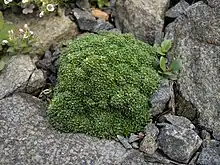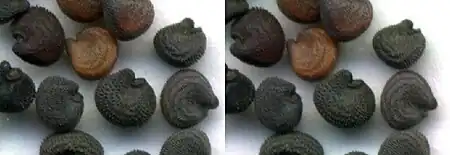Gypsophila
Gypsophila (/dʒɪpˈsɒfɪlə/)[2][3] is a genus of flowering plants in the carnation family, Caryophyllaceae. They are native to Eurasia, Africa, Australia, and the Pacific Islands.[4] Turkey has a particularly high diversity of Gypsophila taxa, with about 35 endemic species.[5] Some[6] Gypsophila are introduced species in other regions.[4]
| Gypsophila | |
|---|---|
.jpg.webp) | |
| Gypsophila repens | |
| Scientific classification | |
| Kingdom: | Plantae |
| Clade: | Tracheophytes |
| Clade: | Angiosperms |
| Clade: | Eudicots |
| Order: | Caryophyllales |
| Family: | Caryophyllaceae |
| Genus: | Gypsophila L. |
| Species | |
|
About 150 | |
| Synonyms[1] | |
|
List
| |
The genus name is from the Greek gypsos ("gypsum") and philios ("loving"), a reference to the gypsum-rich substrates on which some species grow.[4] Plants of the genus are known commonly as baby's-breath, or bebe's breath,[4][7] a name which also refers specifically to the well known ornamental species Gypsophila paniculata.
Description
Gypsophila is one of the most heterogeneous and largest groups in the carnation tribe, Caryophylleae. The genus comprises approximately 150 species of annual or perennial herbaceous, creeping or cushion-forming plants, inhabiting primarily the mountainous steppes in the north temperate part of the Old World with a diversification hotspot in the Irano-Turanian region.[8] These species also show major variation in inflorescence type ranging from many-flowered lax thyrses or panicles (e.g., G. elegans M.Bieb., G. paniculata L., G. pilosa Huds.) to compact head-like cymes ( G. capitata M.Bieb., G. capituliflora Rupr., G. caricifolia Boiss.), and few-(uni-)flowered raceme-like monochasia (e.g., G. bazorganica Rech.f., G. saponarioides Bornm. & Gauba). Each small flower has a cup-like calyx of white-edged green sepals containing five petals in shades of white or pink. The fruit is a rounded or oval capsule opening at valves. It contains several brown or black seeds which are often shaped like a kidney or a snail shell.[4]
Uses
A few species are commercially cultivated for several uses, including floristry, herbal medicine, and food. The baby's-breath most commonly used in flower arrangements such as bouquets is the common gypsophila, G. paniculata.[9] G. elegans is also used as a cut flower.[10]
The genus is a source of saponins that can be used for many purposes, including the production of photographic film and hemolytic laboratory reagents. Their detergent qualities make them useful in soap and shampoo.[9]
G. rokejeka is used to make the dessert halva.[9] Species are also ingredients in liqueur, cheese, and ice cream, providing flavor, aroma, and crispness to foods.[11]
Several species are hyperaccumulators of boron, and may be planted to absorb the element from polluted soils.[11]
Ecology
Some species are known as weeds, including the "aggressive ornamental" G. paniculata, which invades habitat and competes with native flora.[12]
The plant Çöven, G. simonii is widely distributed throughout Çankırı, where it is a native species, and Turkey. In this study, chemical and physical properties of unripe saponins obtained by extraction from the roots of G. simonii, an endemic plant, were isolated and investigated. Purified aglycones recovered from acid hydrolysis of the saponins were separated by reversed chromatography on a thin layer of silica gel. Phytochemical tests showed the presence of terpenoids in the crude extracts.[13][14]
Selected species
There are about 150 species in the genus.[4][15]

| Stereo image | |||
|---|---|---|---|
| |||
| |||
| |||
| |||
| Gypsophila sp. seeds | |||
Species include:
- Gypsophila acantholimoides
- Gypsophila achaia
- Gypsophila acutifolia – sharpleaf baby's-breath
- Gypsophila adenophora
- Gypsophila adenophylla
- Gypsophila albida
- Gypsophila altissima
- Gypsophila antari
- Gypsophila antoninae
- Gypsophila arabica
- Gypsophila aretioides
- Gypsophila arrostii – Arrost's baby's-breath
- Gypsophila aucheri
- Gypsophila aulieatensis
- Gypsophila australis
- Gypsophila bicolor
- Gypsophila capituliflora
- Gypsophila caricifolia
- Gypsophila cephalotes
- Gypsophila davurica
- Gypsophila desertorum
- Gypsophila elegans – showy baby's-breath
- Gypsophila fastigiata – fastigiate gypsophila
- Gypsophila glandulosa
- Gypsophila glomerata
- Gypsophila huashanensis
- Gypsophila imbricata
- Gypsophila intricata
- Gypsophila iranica
- Gypsophila krascheninnikovii
- Gypsophila libanotica
- Gypsophila licentiana
- Gypsophila litwinowii
- Gypsophila nana – dwarf gypsophila
- Gypsophila oldhamiana – Manchurian baby's-breath, Oldham's baby's-breath
- Gypsophila pacifica
- Gypsophila paniculata – baby's-breath, common gypsophila, panicled baby's-breath
- Gypsophila patrinii
- Gypsophila perfoliata – perfoliate gypsophila
- Gypsophila petraea
- Gypsophila pilosa – Turkish baby's-breath
- Gypsophila repens – alpine gypsophila, creeping baby's-breath
- Gypsophila rokejeka
- Gypsophila ruscifolia
- Gypsophila scorzonerifolia – glandular baby's-breath, garden baby's-breath
- Gypsophila sericea
- Gypsophila silenoides
- Gypsophila simonii
- Gypsophila spergulifolia
- Gypsophila spinosa
- Gypsophila stevenii – Steven's baby's-breath
- Gypsophila struthium
- Gypsophila tenuifolia
- Gypsophila tschiliensis
- Gypsophila uralensis
- Gypsophila venusta
- Gypsophila viscosa
- Gypsophila wendelboi
- Gypsophila wilhelminae
- Gypsophila xanthochlora
Gypsophila muralis (annual gypsophila, cushion baby's-breath, low baby's-breath) is now placed in the genus Psammophiliella.[16]
References
- "Gypsophila L." Plants of the World Online. Royal Botanic Gardens, Kew. Retrieved 7 April 2022.
- Sunset Western Garden Book, 1995:606–607
- Gypsophila at USDA PLANTS Database
- Gypsophila. Flora of North America.
- Korkmaz, M., et al. (2012). Habitat properties of some Gypsophila L. (Caryophyllaceae) taxa of Turkey. Biyoloji Bilimleri Araştırma Dergisi (BİBAD) 5(2), 111-25.
- גיבסנית, זר פרחים. "גיבסנית". אלה פרחים.
- Gypsophila. Integrated Taxonomic Information System (ITIS)
- Madhani, Hossein; Rabeler, Richard; Pirani, Atefeh; Oxelman, Bengt; Heubl, Guenther; Zarre, Shahin (2018). "Untangling phylogenetic patterns and taxonomic confusion in tribe Caryophylleae (Caryophyllaceae) with special focus on generic boundaries" (PDF). Taxon. 67 (1): 83–112. doi:10.12705/671.6. hdl:2027.42/146908. ISSN 1996-8175.
- Henry, M. Gypsophila paniculata L. (baby's breath): in vitro culture and the production of gypsogenin saponins. In: Medicinal and Aromatic Plants IV (pp. 187-206). Springer Berlin Heidelberg. 1993.
- Gypsophila elegans. Archived 2013-10-29 at the Wayback Machine Landscape Horticulture. American University of Beirut.
- Korkmaz, M., et al. Economic importance and using purposes of Gypsophila L. and Ankyropetalum Fenzl (Caryophyllaceae) of Türkiye. Archived 2016-03-04 at the Wayback Machine In: 2nd International Symposium on Sustainable Development, June 8–9, 2010, Sarajevo.
- Baby's Breath (Gypsophila paniculata). Plant Health & Pest Management, Ministry of Agriculture, British Columbia.
- Yücekutlu, A. Nihal (2000). Çöven (Gypsophila simonii Hub. Mor) Kökünden Saponin Saflaştırılması, Gazi Üniversitesi Fen Bilimleri Enstitüsü, Kimya, Yüksek Lisans Tezi. 64s. Ankara.
- Yücekutlu, A. Nihal and Bildacı, Işık (2008). "Determination of Plant Saponins and Some of Gypsophila Species. A Review of the Literature". Hacettepe Journal of Biology and Chemistry, 36(2), 129-135.
- Gypsophila. The Plant List.
- "Psammophiliella Ikonn". Plants of the World Online. Royal Botanic Gardens, Kew. Retrieved 2020-02-09.
